| NASA’s Jet Propulsion Laboratory- JPL News – Month in Review, Mars Report on NASA’s Perseverance Rover SuperCam Instrument, SpaceCast Weekly, Jeff Bezos launches to space aboard Blue Origin rocket, Neil deGrasse Tyson-CNN, and Velshi-MSNBC |
NASA’s Jet Propulsion Laboratory <jplnewsroom@jpl.nasa.gov>JPL News – Month in Review Jul 1, 2021
| Mars Report: Update on NASA’s Perseverance Rover SuperCam Instrument
SpaceCast Weekly – July 16, 2021, NASA Video Jeff Bezos launches to space aboard Blue Origin rocket, Streamed live on Jul 20, 2021, CBS News Neil deGrasse Tyson explains significance of Richard Branson’s space flight, Jul 10, 2021 CNNVelshi: We Can Focus on Climate Change & Still Marvel At Space Travel, Jul 17, 2021 MSNBC |
| NASA’s Self-Driving Perseverance Mars Rover ‘Takes the Wheel’ The agency’s newest rover is trekking across the Martian landscape using a newly enhanced auto-navigation system. › Read the full story
|
|
| First You See It, Then You Don’t: Scientists Closer to Explaining Mars Methane Mystery Why do some science instruments detect the gas on the Red Planet while others don’t? › Read the full story |
| Watch (and Hear) How NASA’s Perseverance Rover Took Its First Selfie The historic image of the rover beside the Mars Helicopter proved to be one of the most complex rover selfies ever taken. Video, with bonus audio, sheds light on the process. › Read the full story |
| Study Looks More Closely at Mars’ Underground Water Signals A new paper finds more radar signals suggesting the presence of subsurface ‘lakes,’ but many are in areas too cold for water to remain liquid. › Read the full story |
| My Favorite Martian Image: Jezero Crater’s ‘Delta Scarp’ A Perseverance rover scientist’s favorite shot from the young Mars mission provides a new angle on an old and intriguing surface feature. › Read the full story |
| NASA’s Perseverance Rover Begins Its First Science Campaign on Mars The six-wheeled scientist is heading south to explore Jezero Crater’s lakebed in search of signs of ancient microbial life. › Read the full story |
|||
|
https://www.youtube.com/watch?v=KrtzK-q2Yzk&list=PLTiv_XWHnOZpDDRIMGNxDTAORJVK2RS7I
|
NASA’s InSight Mars Lander Gets a Power Boost The spacecraft successfully cleared some dust off its solar panels, helping to raise its energy and delay when it will need to switch off its science instruments. › Read the full story |
This message was sent to ingpeaceproject@gmail.com from jplnewsroom@jpl.nasa.gov
NASA’s Jet Propulsion Laboratory
NASAJPL
4800 Oak Grove Dr
Pasadena, CA 91109
NASA Jet Propulsion Laboratory
1 / 9
The End of One Drive by Perseverance on the Floor of Jezero Crater
Jul 21, 2021
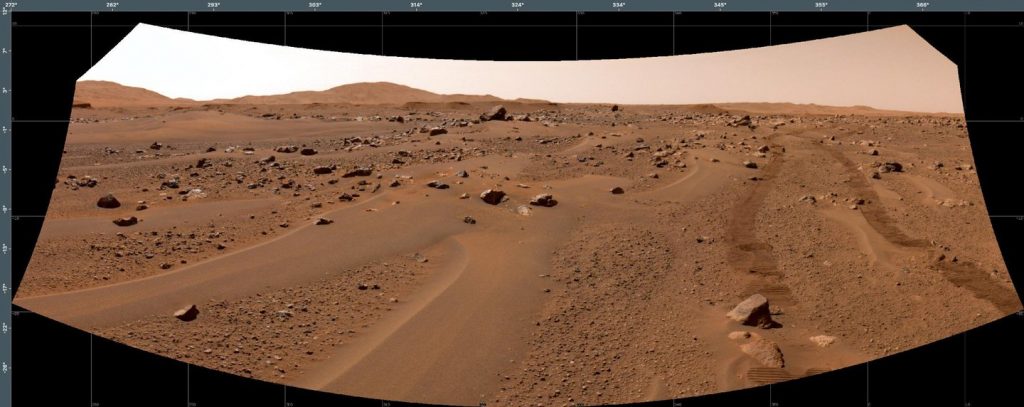 This image of a Martian vista in Jezero Crater, made from smaller individual images, was taken by NASA’s Perseverance rover on July 3, 2021 (the 131th sol, or Martian day, of its mission). The rover’s tracks from its autonomous drive that day are visible on the right. The images that compose the larger mosaic came from the rover’s Navigation Cameras and were processed to enhance the contrast.
This image of a Martian vista in Jezero Crater, made from smaller individual images, was taken by NASA’s Perseverance rover on July 3, 2021 (the 131th sol, or Martian day, of its mission). The rover’s tracks from its autonomous drive that day are visible on the right. The images that compose the larger mosaic came from the rover’s Navigation Cameras and were processed to enhance the contrast.
Perseverance has been exploring the floor of Jezero since it landed on Feb. 18, 2021.
A key objective for Perseverance’s mission on Mars is astrobiology, including the search for signs of ancient microbial life. The rover will characterize the planet’s geology and past climate, pave the way for human exploration of the Red Planet, and be the first mission to collect and cache Martian rock and regolith (broken rock and dust).
The Mars 2020 Perseverance mission is part of NASA’s Moon to Mars exploration approach, which includes Artemis missions to the Moon that will help prepare for human exploration of the Red Planet.
Subsequent NASA missions, in cooperation with ESA (European Space Agency), would send spacecraft to Mars to collect these sealed samples from the surface and return them to Earth for in-depth analysis.
NASA’s Jet Propulsion Laboratory in Southern California built and manages operations of the Mars 2020 Perseverance rover for NASA.
For more information about the mission, go to: https://mars.nasa.gov/mars2020
Perseverance Rover Camera View of Long Autonomous Drive
Jul 21, 2021
This video from July 1, 2021 (the 130th sol, or Martian day, of its mission), shows scenes from the longest autonomous drive yet for NASA’s Perseverance Mars rover, which landed on Feb. 18, 2021. At the beginning of the traverse on Sol 130, the rover’s engineers manually drove past NASA’s Ingenuity Mars Helicopter. Then the rover began driving autonomously, avoiding hazards and traveling 358 feet (109 meters) on its own.
One of the rover’s Navigation Cameras took the images about once every 16 feet (5 meters). They were processed to enhance the contrast.
NASA’s Jet Propulsion Laboratory in Southern California built and manages operations of the Mars 2020 Perseverance rover for NASA.
For more information about the mission, go to: https://mars.nasa.gov/mars2020
Perseverance Scouts First Sampling Location
Jul 21, 2021
This image shows the area on Mars from which NASA’s Perseverance rover will collect its first rock sample. Scientists are particularly interested in the flat stones that appear light-colored (informally called “paver rocks”). The Perseverance team has nicknamed this area in Mars’ Jezero Crater the “Crater Floor Fractured Rough” area.
The 28 individual images that were combined to make the larger main image were taken by the rover’s Mastcam-Z right-eye camera on July 8, 2021 (the 136th sol, or Martian day, of the mission). The images have been calibrated and are presented in natural color, simulating the approximate view that we would see with our own eyes if we were there.
A second version (Figure 1) combines 56 individual images from the rover’s Mastcam-Z left-eye and right-eye cameras on the same day. The images have been calibrated and are presented as a natural color anaglyph (for red-blue glasses), simulating the approximate 3D and color view that we would see with our own eyes if we were there.
The Mastcam-Z investigation is led and operated by Arizona State University in Tempe, working in collaboration with Malin Space Science Systems in San Diego, California, on the design, fabrication, testing, and operation of the cameras, and in collaboration with the Neils Bohr Institute of the University of Copenhagen on the design, fabrication, and testing of the calibration targets.
NASA’s Jet Propulsion Laboratory in Southern California built and manages operations of the Mars 2020 Perseverance rover for NASA.
For more about Perseverance: mars.nasa.gov/mars2020
Witness Tube in Perseverance Sample Caching System
Jul 21, 2021
As part of its search for signs of ancient life on Mars, Perseverance is the first rover to bring a sample caching system to the Red Planet that will package promising samples for return to Earth by a future mission. This series of images shows NASA’s Perseverance rover inspecting and sealing a “witness” sample tube on June 21, 2021 (the 120th sol, or Martian day, of the mission), as it prepares to collect its first sample of Martian rock and sediment.
Witness tubes are similar to the sample tubes that will hold Martian rock and sediment, except they have been preloaded with a variety of materials that can capture molecular and particulate contaminants. They are opened on the Martian surface to “witness” the ambient environment near sample collection sites. With samples returned to Earth in the future, the witness tubes would show whether Earth contaminants were present during sample collection. Such information would help scientists tell which materials in the Martian samples may be of Earth origin.
The sampling system’s dedicated camera, the Cachecam, captured these images.
NASA’s Jet Propulsion Laboratory in Southern California built and manages operations of the Mars 2020 Perseverance rover for NASA.
For more information about the mission, go to: https://mars.nasa.gov/mars2020
SuperCam Image of Artuby
Jul 21, 2021
Click on images for larger versions
NASA’s Perseverance rover took these zoomed-in images of a layered outcrop (just below center of image) nicknamed “Artuby” on June 17, 2021 (the 116th sol, or Martian Day, of its mission), from a little more than a third of a mile (615 meters) away. This mosaic is made up of three images taken by the Remote Microscopic Imager (RMI), part of the rover’s SuperCam instrument. Each circular image has a field of view of 37.73 feet (11.50 meters) at this distance. The images were combined using an algorithm that weights the image centers.
The outcrop shows evidence of being formed in an ancient lake. The feature is in the ‘Verdon’ quadrangle of Mars’ Jezero Crater, south of the landing site. Artuby is the name of a river in southern France.
One version (Figure 1) uses a Gaussian color stretch to make it easier to see differences among the colors. Another version (Figure 2) shows natural color, simulating the approximate view that we would see with our own eyes if we were on Mars.
Perseverance has been exploring the floor of Jezero Crater since it landed on Feb. 18, 2021.
SuperCam is led by Los Alamos National Laboratory in New Mexico, where the instrument’s Body Unit was developed. That part of the instrument includes several spectrometers as well as control electronics and software.
The Mast Unit, including the RMI used for these images, was developed and built by several laboratories of the CNRS (the French research center) and French universities under the contracting authority of Centre National d’Etudes Spatiales (CNES, the French space agency).
NASA’s Jet Propulsion Laboratory in Southern California built and manages operations of the Mars 2020 Perseverance rover for NASA.
For more about Perseverance: mars.nasa.gov/mars2020/ and nasa.gov/perseverance
Perseverance Looks Back After a Long Autonomous Drive
Jul 21, 2021
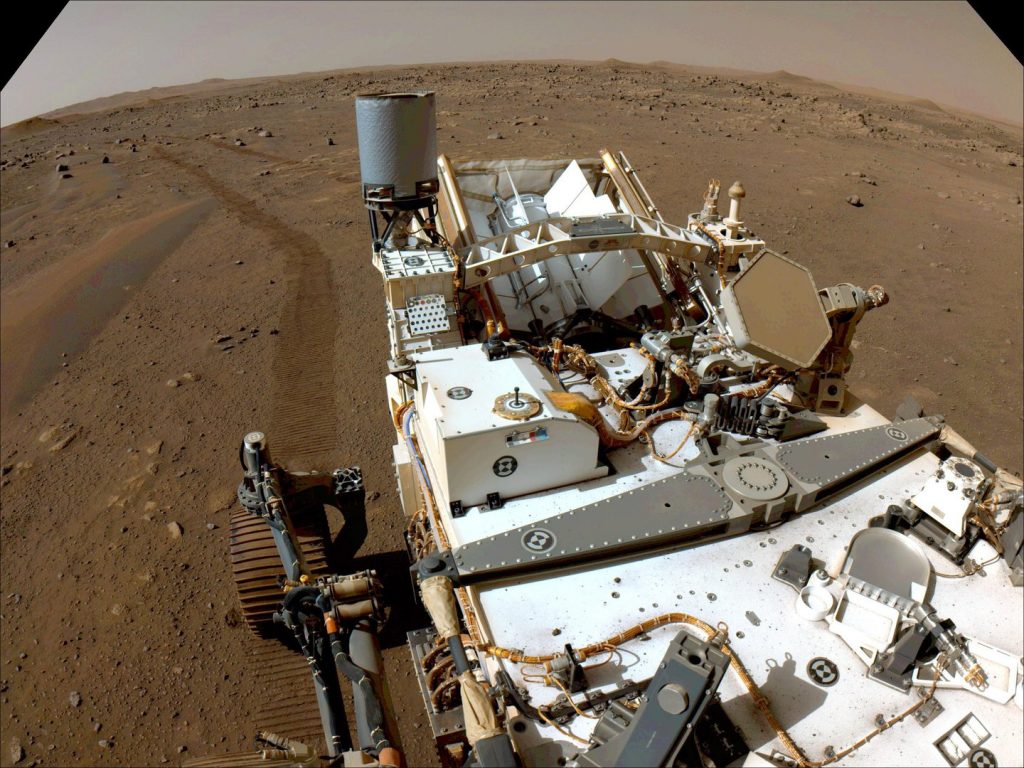 NASA’s Perseverance Mars rover looks back toward its tracks on July 1, 2021 (the 130th sol, or Martian day, of its mission), after driving autonomously 358 feet (109 meters) – its longest autonomous drive to date. Taken by one of the rover’s Navigation Cameras, the image has been processed to enhance the contrast.
NASA’s Perseverance Mars rover looks back toward its tracks on July 1, 2021 (the 130th sol, or Martian day, of its mission), after driving autonomously 358 feet (109 meters) – its longest autonomous drive to date. Taken by one of the rover’s Navigation Cameras, the image has been processed to enhance the contrast.
Perseverance has been exploring the floor of Jezero Crater since it landed on Feb. 18, 2021.
NASA’s Jet Propulsion Laboratory in Southern California built and manages operations of the Mars 2020 Perseverance rover for NASA.
For more information about the mission, go to: https://mars.nasa.gov/mars2020
An Expanse for Perseverance to Explore
Jul 21, 2021

Figure 3
Click on images for larger versions
This wide view of Mars’ Jezero Crater was taken by NASA’s Perseverance rover on July 15, 2021 (the 143rd sol, or Martian day, of its mission). The rover has driven nearly a mile (1.5 kilometers) south of its landing site, “Octavia E. Butler Landing,” into a region the team has nicknamed the “Crater Floor Fractured Rough” unit. The stones that appear light-colored and flat in this image (Figure 1) are informally referred to as the “paver rocks” and will be the first type from which Perseverance will collect a sample for planned return to Earth by subsequent missions. Small hills to the south of the rover and the sloping inner walls of the Jezero Crater rim fill the distant background of this view.
Five images from the rover’s Mastcam-Z instrument were calibrated and combined to make this mosaic. One version (main image), presented in natural color, simulates the approximate view that we would see with our own eyes if we were there. Another version (Figure 2) is presented in enhanced color to exaggerate the subtle red, green, and blue color differences among the materials in this scene.
A third version (Figure 3) combines the five images from both the left and right Mastcam-Z cameras into an anaglyph (for red-blue glasses) that simulate a 3D view of the scene in enhanced color.
Perseverance has been exploring the floor of Jezero since landing on Feb. 18, 2021.
The Mastcam-Z investigation is led and operated by Arizona State University in Tempe, working in collaboration with Malin Space Science Systems in San Diego, California, on the design, fabrication, testing, and operation of the cameras, and in collaboration with the Neils Bohr Institute of the University of Copenhagen on the design, fabrication, and testing of the calibration targets.
NASA’s Jet Propulsion Laboratory in Southern California built and manages operations of the Mars 2020 Perseverance rover for NASA.
For more information about the mission, go to: https://mars.nasa.gov/mars2020
How Perseverance Thinks While Driving
Jul 21, 2021
This engineering animation shows how NASA’s Perseverance rover analyzed the Martian landscape and autonomously steered around a hazard for the first time on Mars. The rover built a 3D map of its surroundings using its stereo cameras, generated a set of candidate paths to the goal, and selected the fastest one that is free of obstacles.
This drive took place on June 23, 2021 (the 122nd sol, or Martian day, of its mission).
Perseverance has been exploring the floor of Jezero Crater since it landed on Feb. 18, 2021.
NASA’s Jet Propulsion Laboratory in Southern California built and manages operations of the Mars 2020 Perseverance rover for NASA.
For more information about the mission, go to: https://mars.nasa.gov/mars2020
Perseverance’s Arm Over Paver Rocks
Jul 20, 2021
The robotic arm on NASA’s Perseverance rover reached out to examine rocks in an area on Mars nicknamed the “Cratered Floor Fractured Rough” area in this image captured on July 10, 2021 (the 138th sol, or Martian day, of its mission). The image was taken by one of the rover’s hazard cameras. An additional set of images from July 10-12 have been compiled into a GIF.
Scientists are particularly interested in the flat rocks that appear light in color (nicknamed “paver rocks”). This image was processed to enhance contrast.
JPL, which is managed for NASA by Caltech in Pasadena, California, built and manages operations of the Perseverance rover.
WATSON Views Foux
Jul 20, 2021
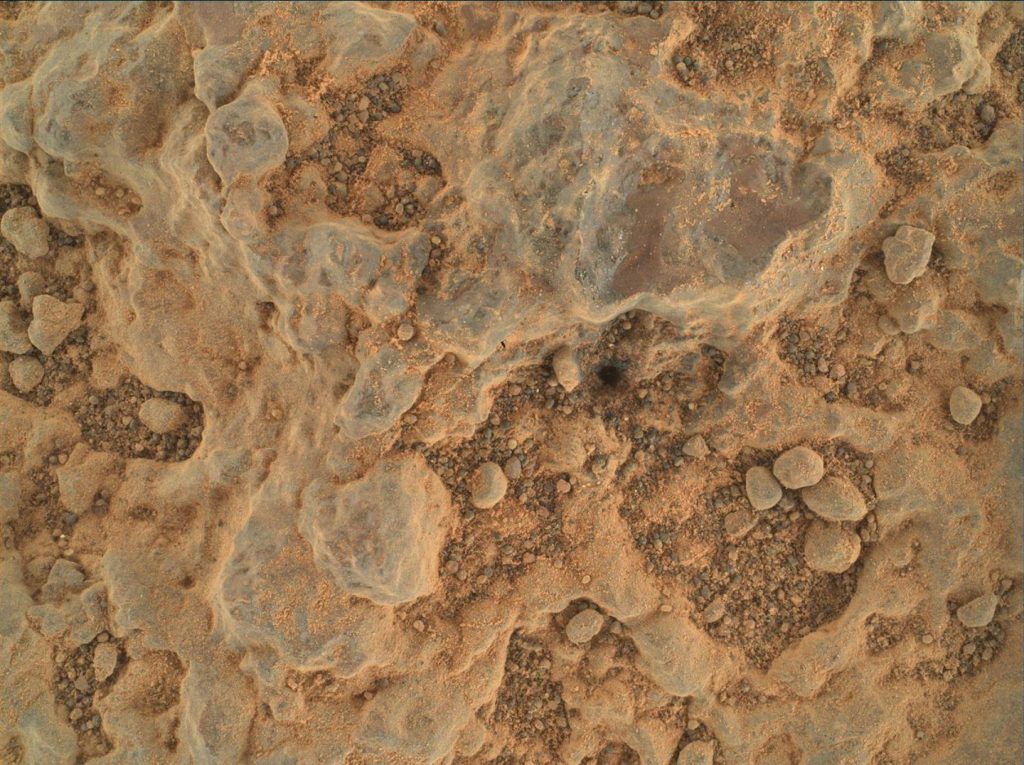 NASA’s Perseverance Mars rover took this close-up of a rock target nicknamed “Foux” using its WATSON (Wide Angle Topographic Sensor for Operations and eNgineering) camera, part of the SHERLOC instrument on the end of the rover’s robotic arm. The image was taken July 11, 2021, the 139th Martian day, or sol, of the mission. The area within the camera is roughly 1.4 by 1 inches (3.5 centimeters by 2.6 centimeters).
NASA’s Perseverance Mars rover took this close-up of a rock target nicknamed “Foux” using its WATSON (Wide Angle Topographic Sensor for Operations and eNgineering) camera, part of the SHERLOC instrument on the end of the rover’s robotic arm. The image was taken July 11, 2021, the 139th Martian day, or sol, of the mission. The area within the camera is roughly 1.4 by 1 inches (3.5 centimeters by 2.6 centimeters).
NASA’s Jet Propulsion Laboratory built and manages operations of Perseverance and Ingenuity for the agency. Caltech in Pasadena, California, manages JPL for NASA. WATSON was built by Malin Space Science Systems (MSSS) in San Diego and is operated jointly by MSSS and JPL.
JPL, which is managed for NASA by Caltech in Pasadena, California, built and manages operations of the Perseverance rover.
PIXL’s First Chemical Maps
Jul 20, 2021
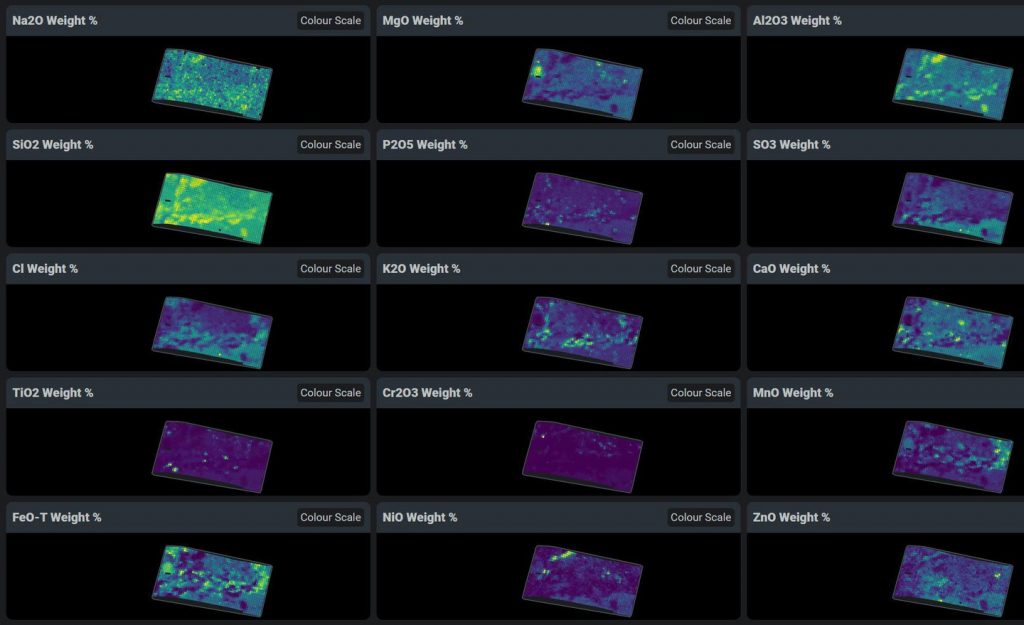 This data shows chemicals detected within a single rock on Mars by the Planetary Instrument for X-ray Lithochemistry (PIXL), one of the instruments on the end of the robotic arm aboard NASA’s Perseverance Mars rover. PIXL allows scientists to study where specific chemicals can be found within an area as small as a postage stamp.
This data shows chemicals detected within a single rock on Mars by the Planetary Instrument for X-ray Lithochemistry (PIXL), one of the instruments on the end of the robotic arm aboard NASA’s Perseverance Mars rover. PIXL allows scientists to study where specific chemicals can be found within an area as small as a postage stamp.
JPL, which is managed for NASA by Caltech in Pasadena, California, built and manages operations of the Perseverance rover.
Jul 22, 2021
The Little (Mars) Helicopter That Could
 Ingenuity, the helicopter that arrived on the Red Planet on the Mars Perseverance rover, has made nine flights on Mars. Ingenuity’s historic achievement is the first powered helicopter flight on a terrestrial body other than Earth.
Ingenuity, the helicopter that arrived on the Red Planet on the Mars Perseverance rover, has made nine flights on Mars. Ingenuity’s historic achievement is the first powered helicopter flight on a terrestrial body other than Earth.
According to Håvard F. Grip, Ingenuity Chief Pilot, and Ken Williford, Perseverance Deputy Project Scientist, Flight 9, which occurred in July 2021, was unlike the flights that came before it. It broke our records for flight duration and cruise speed, and it nearly quadrupled the distance flown between two airfields. But what really set the flight apart was the terrain that Ingenuity had to negotiate during its 2 minutes and 46 seconds in the air – an area called “Séítah” that would be difficult to traverse with a ground vehicle like the Perseverance rover. This flight was also explicitly designed to have science value by providing the first close view of major science targets that the rover will not reach for quite some time.
But the Mars Perseverance team didn’t do it alone. A team of helicopter experts from our Ames Research Center in California assisted the Ingenuity team in making sure the technology demonstrator had the best chance for success in flying in the super thin atmosphere of the Red Planet. Learn more.
This image was captured by Mars Perseverance rover using its Left Mastcam-Z Camera, composed of a pair of cameras located high on the rover’s mast, on Jun. 15, 2021 (Sol 114).
Image Credit: NASA/JPL-Caltech/ASU
Last Updated: Jul 22, 2021
Editor: Yvette Smith
Tags: Aeronautics, Image of the Day, Mars
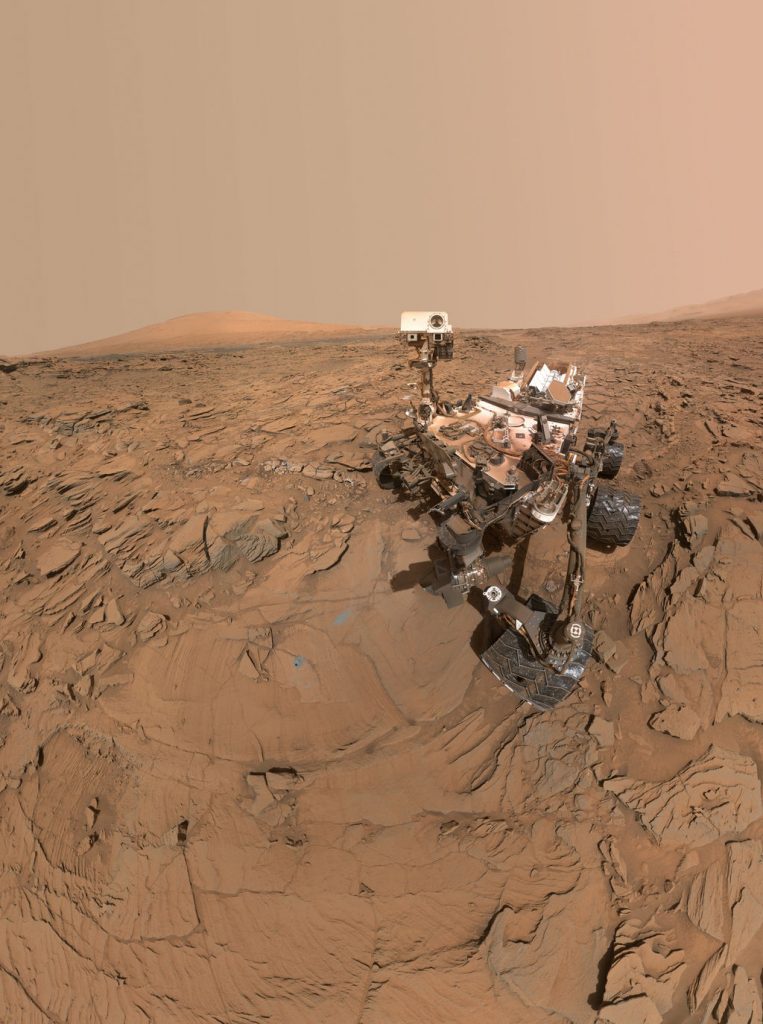 For more information, please visit the following link:
For more information, please visit the following link:
https://www.nasa.gov/mission_pages/msl/images/index.html
Mission Galleries
View images from our missions exploring the universe and our home planet. For a list of all missions, visit the missions A-Z page.
- Mars Curiosity Rover
- Juno Mission to Jupiter
- International Space Station
- Space Launch System Rocket
- Orion Spacecraft
- Earth Missions
SpaceCast Weekly – July 16, 2021
Jul 16, 2021 NASA Video 29:01 mins
SpaceCast Weekly is a NASA Television broadcast from the Johnson Space Center in Houston featuring stories about NASA’s work in human spaceflight, including the International Space Station and its crews and scientific research activities, and the development of Orion and the Space Launch System, the next generation American spacecraft being built to take humans farther into space than they’ve ever gone before.
Jeff Bezos launches to space aboard Blue Origin rocket
Streamed live on Jul 20, 2021 CBS News
Jeff Bezos launched into space on Tuesday on the New Shepard rocket built by his company, Blue Origin. Bezos was joined by his brother Mark and two history-making passengers: 82-year-old aviation pioneer Wally Funk, the oldest person to fly in space, and Oliver Daemen, an 18-year-old Dutch student who is the youngest ever to fly in space. CBSN is CBS News’ 24/7 digital streaming news service featuring live, anchored coverage available for free across all platforms. Launched in November 2014, the service is a premier destination for breaking news and original storytelling from the deep bench of CBS News correspondents and reporters. CBSN features the top stories of the day as well as deep dives into key issues facing the nation and the world. CBSN has also expanded to launch local news streaming services in major markets across the country. CBSN is currently available on CBSNews.com and the CBS News app across more than 20 platforms, as well as the Paramount+ subscription service. Subscribe to the CBS News YouTube channel: http://youtube.com/cbsnews? Watch CBSN live: http://cbsn.ws/1PlLpZ7c? Download the CBS News app: http://cbsn.ws/1Xb1WC8? Follow CBS News on Instagram: https://www.instagram.com/cbsnews/? Like CBS News on Facebook: http://facebook.com/cbsnews? Follow CBS News on Twitter: http://twitter.com/cbsnews? Subscribe to our newsletters: http://cbsn.ws/1RqHw7T? Try Paramount+ free: https://bit.ly/2OiW1kZ For video licensing inquiries, contact: licensing@veritone.com
Neil deGrasse Tyson explains significance of Richard Branson’s space flight
Jul 10, 2021 CNN
Astrophysicist Neil deGrasse Tyson explains what Richard Branson’s space flight could mean for the future of space tourism. #CNN #News
Velshi: We Can Focus On Climate Change & Still Marvel At Space Travel
Jul 17, 2021 MSNBC
There are valid criticisms of the commercial space industry. But let’s separate the criticisms of Bezos, Branson, and Musk from the remarkable achievements we are witnessing. Where the critics are wrong is in thinking last week’s Virgin Galactic launch and next week’s Blue Origin launch aren’t important and meaningful advances. I share your sense of urgency about social justice, democracy, climate change, public education, poverty eradication and higher wages. We can fix all of those things and still marvel at a space launch and dream about traveling to space or being the engineers, scientists and pilots who get us there.» Subscribe to MSNBC: http://on.msnbc.com/SubscribeTomsnbc

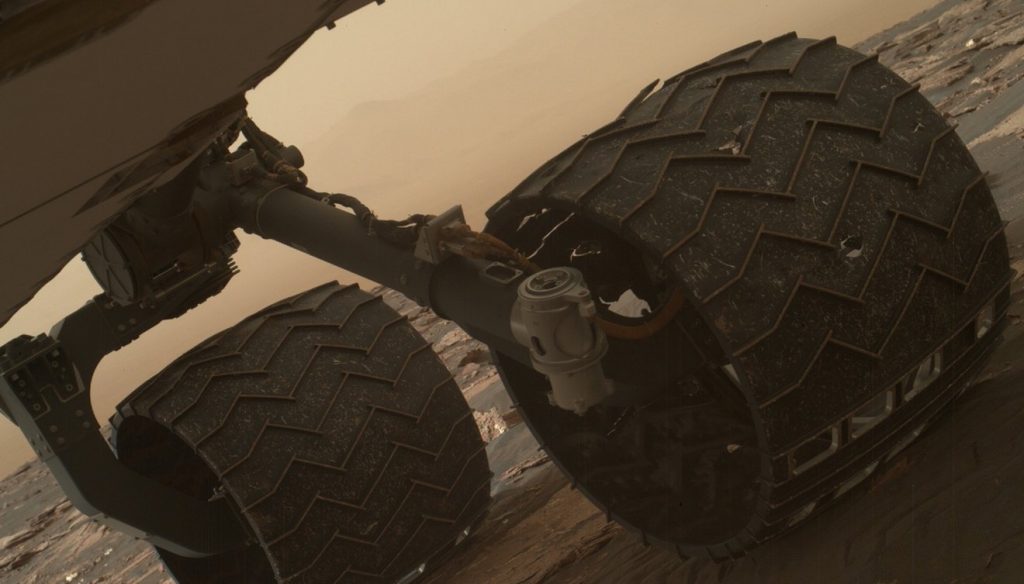
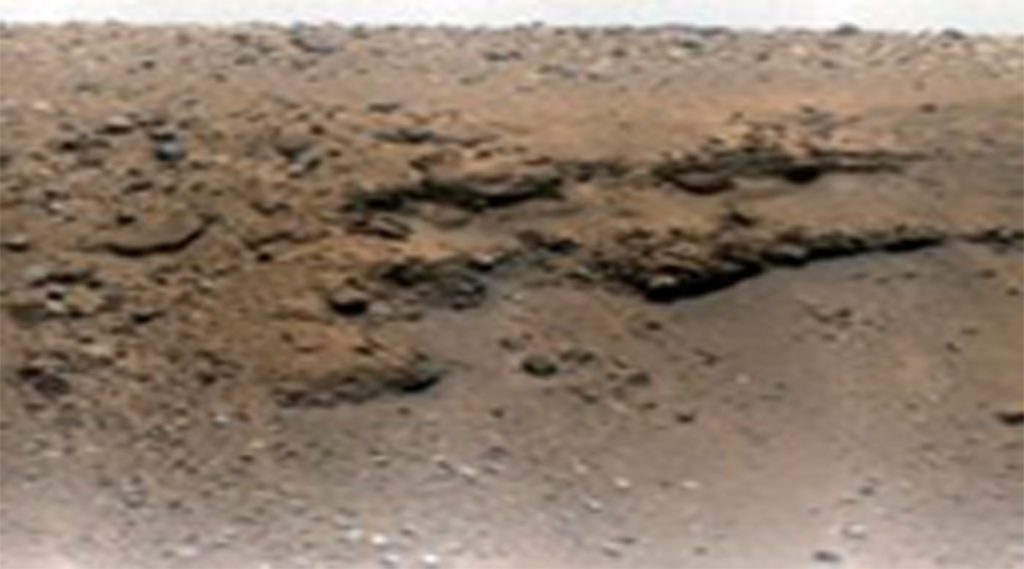

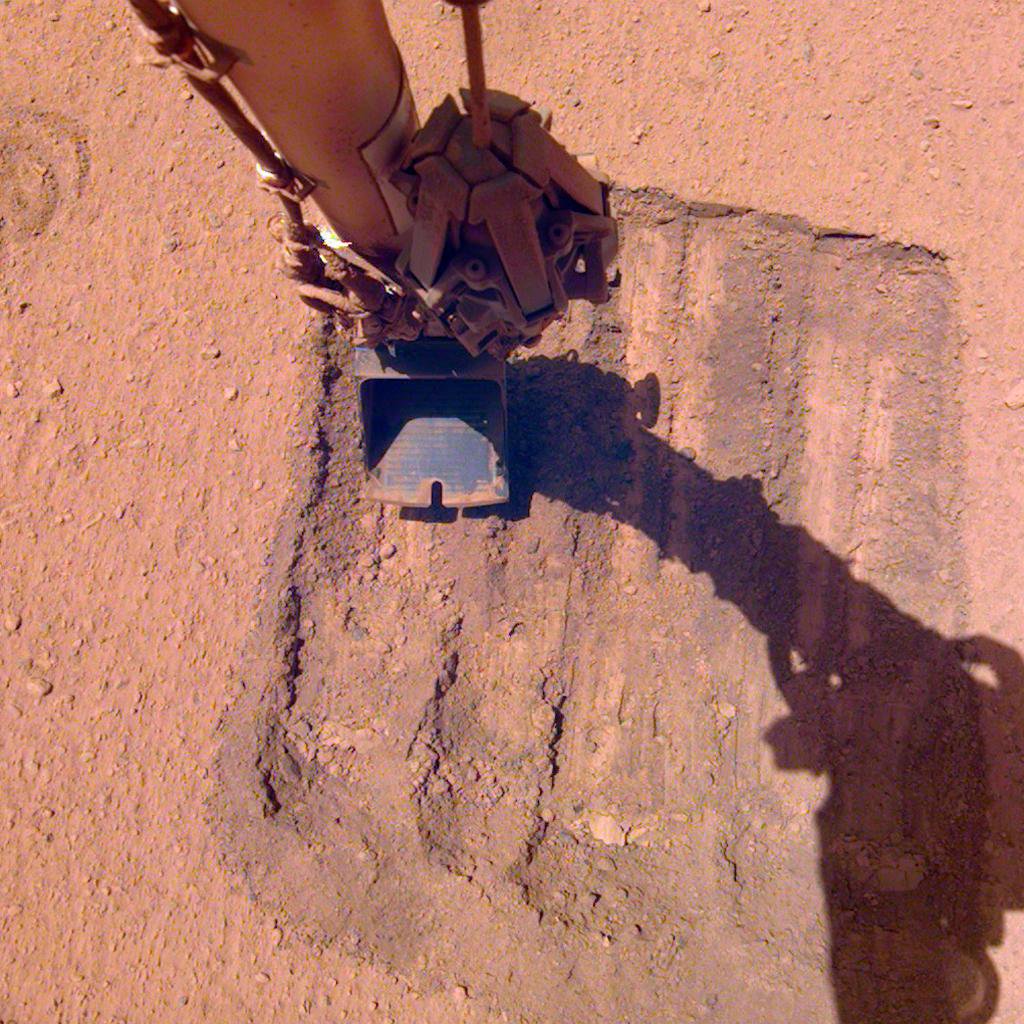

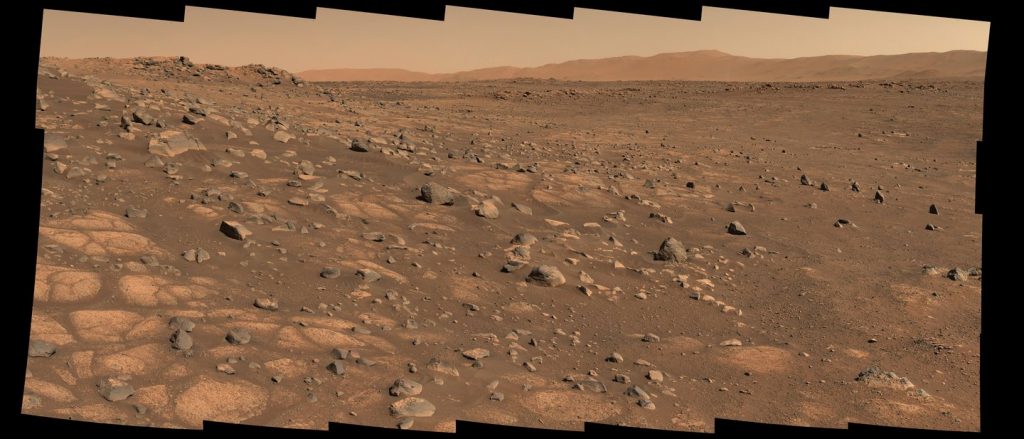





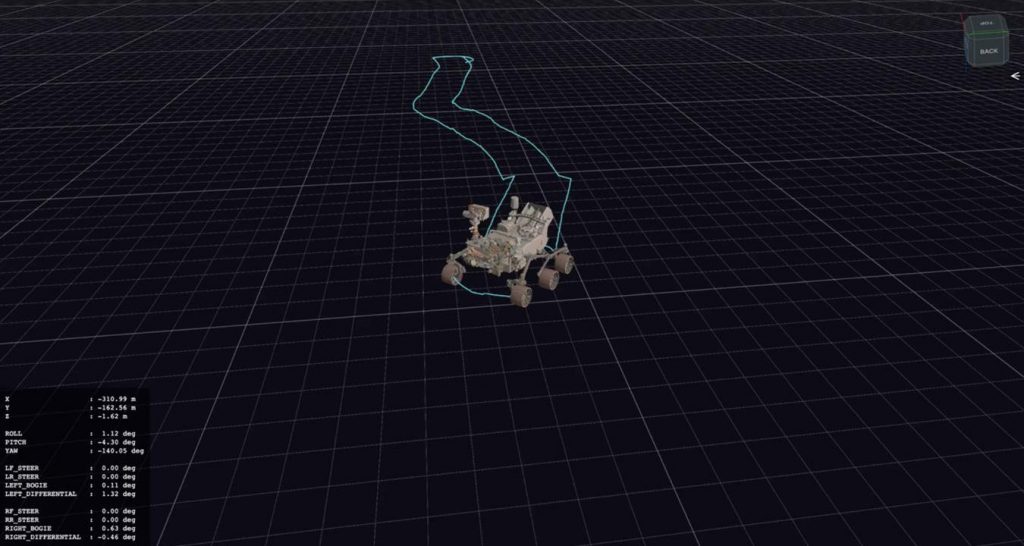

Leave a Reply